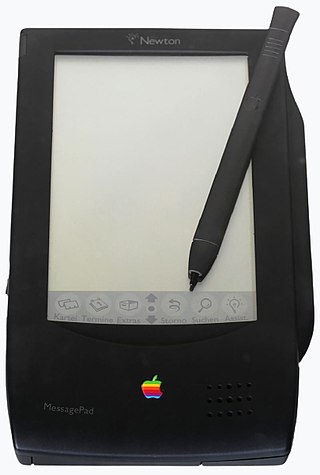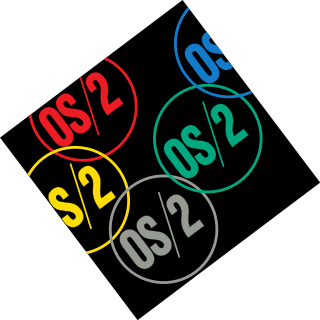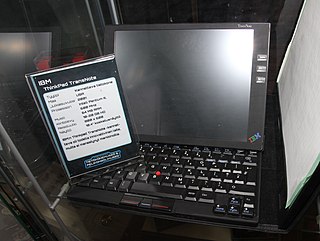Related Research Articles

The MessagePad is a series of personal digital assistant devices developed by Apple Computer for the Newton platform, first released in 1993. Some electronic engineering and the manufacture of Apple's MessagePad devices was undertaken in Japan by Sharp. The devices are based on the ARM 610 RISC processor, run Newton OS, and all feature handwriting recognition software. Alongside the MessagePad series, Apple also developed and released the eMate 300 Newton device.

A graphical user interface, or GUI, is a form of user interface that allows users to interact with electronic devices through graphical icons and visual indicators such as secondary notation. In many applications, GUIs are used instead of text-based UIs, which are based on typed command labels or text navigation. GUIs were introduced in reaction to the perceived steep learning curve of command-line interfaces (CLIs), which require commands to be typed on a computer keyboard.

The technology of computer keyboards includes many elements. Many different keyboard technologies have been developed for consumer demands and optimized for industrial applications. The standard full-size (100%) computer alphanumeric keyboard typically uses 101 to 105 keys; keyboards integrated in laptop computers are typically less comprehensive.
Windows is a product line of proprietary graphical operating systems developed and marketed by Microsoft. It is grouped into families and sub-families that cater to particular sectors of the computing industry – Windows (unqualified) for a consumer or corporate workstation, Windows Server for a server and Windows IoT for an embedded system. Windows is sold as either a consumer retail product or licensed to third-party hardware manufacturers who sell products bundled with Windows.

In computing, a pointing device gesture or mouse gesture is a way of combining pointing device or finger movements and clicks that the software recognizes as a specific computer event and responds to accordingly. They can be useful for people who have difficulties typing on a keyboard. For example, in a web browser, a user can navigate to the previously viewed page by pressing the right pointing device button, moving the pointing device briefly to the left, then releasing the button.

OS/2 is a proprietary computer operating system for x86 and PowerPC based personal computers. It was initially created and developed jointly by IBM and Microsoft, under the leadership of IBM software designer Ed Iacobucci, intended as a replacement for DOS. The first version was released in 1987; a feud between the two companies beginning in 1990 resulted in Microsoft leaving development exclusively to IBM, who continued development on their own. OS/2 Warp 4 in 1996 was the last major upgrade, after which IBM slowly halted the product as it failed to compete against Microsoft's Windows; updated versions of OS/2 were released by IBM until 2001.
Shareware is a type of proprietary software that is initially shared by the owner for trial use at little or no cost. Often the software has limited functionality or incomplete documentation until the user sends payment to the software developer. Shareware is often offered as a download from a website. Shareware differs from freeware, which is fully-featured software distributed at no cost to the user but without source code being made available; and free and open-source software, in which the source code is freely available for anyone to inspect and alter.

A graphics tablet is a computer input device that enables a user to hand draw or paint images, animations and graphics, with a special pen-like stylus, similar to the way a person draws pictures with a pencil and paper by hand.

Handwriting recognition (HWR), also known as handwritten text recognition (HTR), is the ability of a computer to receive and interpret intelligible handwritten input from sources such as paper documents, photographs, touch-screens and other devices. The image of the written text may be sensed "off line" from a piece of paper by optical scanning or intelligent word recognition. Alternatively, the movements of the pen tip may be sensed "on line", for example by a pen-based computer screen surface, a generally easier task as there are more clues available. A handwriting recognition system handles formatting, performs correct segmentation into characters, and finds the most possible words.

ThinkPad is a line of business-oriented laptop and tablet computers produced since 1992. The early models were designed, developed and marketed by International Business Machines (IBM) until it sold its PC business to Lenovo in 2005; since 2007, all new ThinkPad models have been branded Lenovo instead and the Chinese manufacturer has continued to develop and sell ThinkPads to the present day.

Microsoft SideWinder is a former brand name for a family of video gaming peripherals developed by Microsoft for PCs. It was initially marketed from 1995 to 2003 consisting of game controllers, then again from 2007 until the early 2010s with gaming mice and keyboards.

Newton OS is a discontinued operating system for the Apple Newton PDAs produced by Apple Computer, Inc. between 1993 and 1997. It was written entirely in C++ and trimmed to be low power consuming and use the available memory efficiently. Many applications were pre-installed in the ROM of the Newton to save on RAM and flash memory storage for user applications.
The Fly Pentop Computer and FLY Fusion Pentop Computer are personal electronics products manufactured by LeapFrog Enterprises Inc. They are called a "pentop" computer by its manufacturer, because they consist of a pen with a computer inside.

An ultra-mobile PC, or ultra-mobile personal computer (UMPC), is a miniature version of a pen computer, a class of laptop whose specifications were launched by Microsoft and Intel in Spring 2006. Sony had already made a first attempt in this direction in 2004 with its Vaio U series, which was only sold in Asia. UMPCs are generally smaller than subnotebooks, have a TFT display measuring (diagonally) about 12.7 to 17.8 centimetres, are operated like tablet PCs using a touchscreen or a stylus, and can also have a physical keyboard. There is no clear boundary between subnotebooks and ultra-mobile PCs, but UMPCs commonly have major features not found in the common clamshell laptop design, such as small keys on either side of the screen, or a slide-out keyboard.

The IBM ThinkPad 380 was a notebook computer series released May 13, 1997 by IBM as part of their ThinkPad laptop series. Notable for incorporating a CD-ROM and a floppy drive, it was considered a mid-range laptop by IBM at the time, and sold well. The series was the successor to the IBM ThinkPad 365.

Pen computing refers to any computer user-interface using a pen or stylus and tablet, over input devices such as a keyboard or a mouse.
The Microsoft Java Virtual Machine (MSJVM) is a discontinued proprietary Java virtual machine from Microsoft. It was first made available for Internet Explorer 3 so that users could run Java applets when browsing on the World Wide Web. It was the fastest Windows-based implementation of a Java virtual machine for the first two years after its release. Sun Microsystems, the creator of Java, sued Microsoft in October 1997 for incompletely implementing the Java 1.1 standard. It was also named in the United States v. Microsoft Corp. antitrust civil actions, as an implementation of Microsoft's "Embrace, extend and extinguish" strategy. In 2001, Microsoft settled the lawsuit with Sun and discontinued its Java implementation.
The history of tablet computers and the associated special operating software is an example of pen computing technology, and thus the development of tablets has deep historical roots. The first patent for a system that recognized handwritten characters by analyzing the handwriting motion was granted in 1914. The first publicly demonstrated system using a tablet and handwriting recognition instead of a keyboard for working with a modern digital computer dates to 1956.

The ThinkPad T series is a line of notebook computers manufactured by Lenovo as part of the ThinkPad family. The T series is officially the flagship ThinkPad product, offering high-performance computers aimed at businesses and professionals. The ThinkPad X series was originally introduced in 2000 and was produced by IBM until 2005.

The IBM ThinkPad TransNote is a notebook computer by IBM.
References
- ↑ USCA1 Opinion Archived 2007-09-12 at the Wayback Machine
- ↑ "Cross – CrossPad Product Support". Archived from the original on 2011-07-08. Retrieved 2007-07-14.
- ↑ A. T. Cross: Introduces CrossPad XP Archived 1999-12-01 at the Wayback Machine
- ↑ HR&S Claims Administration - Cases Archived 2007-07-29 at the Wayback Machine